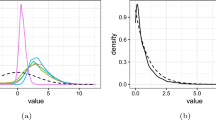Abstract
Data on the virtual dipole moment (VDP) is distributed nonuniformly with time, which significantly complicates qualitative and quantitative analysis of its evolution. In addition to the moving average method and median values, for the first time, a technique is presented for a quasi-uniform presentation of data (interpolation method), as well as results of calculating the evolution of the VDM by this method for the Phanerozoic.
Similar content being viewed by others
References
F. Mosteller and J. W. Tukey, Data Analysis and Regression (Wiley, New York, 1977; Finansy i Statistika, Moscow, 1982).
S. L. Shalimov, “The causes of superchrons of the geomagnetic field,” Geofiz. Issled., No. 6, 59–70 (2006).
A. A. Schreider, “Magnetism of the ocean crust and linear paleomagnetic anomalies,” Fiz. Zemli, No. 6, 59–70 (1992).
A. A. Schreider, A. A. Ignatova, Al. A. Schreider, A. E. Sajneva, P. Varga, and C. Denis, “Evolution of calculations of the virtual dipole moment of the Earth for reconstructing the oceanic inversion magnetic layer’s parameters,” Oceanology (Engl. Transl.) 56, 428–434 (2016).
A. A. Schreider, Al. A. Schreider, P. Varga, and C. Denis, “Variations in the magnitude of the geomagnetic dipole in the interval of chronos C1-M43,” Oceanology (Engl. Transl.) 45, 745–749 (2005).
A. A. Schreider, Al. A. Schreider, P. Varga, and C. Denis, “Variations of the geomagnetic dipole magnitude over the past 400 My,” Oceanology (Engl. Transl.) 48, 250–254 (2008).
A. A. Schreider, Al. A. Schreider, P. Varga, and C. Denis, “Variations of the Earth’s magnetic field in the Phanerozoic,” Oceanology (Engl. Transl.) 51 (3), 506–510 (2011).
V. P. Shcherbakov and N. K. Sycheva, “On the variation in the geomagnetic dipole over the geological history of the Earth,” Izv. Phys. Solid Earth 42 (3), 201–206 (2006).
L. Alva-Valdivia, A. Goguitchaichvili, and J. Urrutia- Fucugauchi, “Further constraints for the Plio- Pleistocene geomagnetic field strength: new results from the los Tuxtlas volcanic field (Mexico),” Earth Planet. Space 53, 873–881 (2001).
A. Biggin, A. McCormik, and A. Roberts, “Paleointensity database updated and upgraded,” EOS 91 (2), 15 (2010).
A. J. Biggin, G. Stirk, and C. Langeris, “The intensity of the geomagnetic field in the late Archaean: new measurements and an analysis of the updated IAGA paleointensity database,” Earth Planet. Space 61, 9–22 (2009).
A. J. Biggin and D. N. Thomas, “Analysis of long-tern variations in the geomagnetic poloidal field intensity and evaluation of their relationship with global geodynamics,” Geophys. J. Int. 152, 392–415 (2003).
Borokpint. http://www.brk.adm.yar.ru/palmag/index/ html.2012.
F. Donadini, “Features of the Geomagnetic field during the Holocene and Proterozoic,” Rep. Ser. Geophys. 58, 113–128 (2007).
F. Gradstein, J. Ogg, M. Schmitz, and G. Ogg, The Geologic Timescale 2012 (Elsevier, Amsterdam, 2012).
IAGA paleointensity database. http://www.isteem.univmontp2. fr/PERSO/perrin/2015.
M. Juarez and L. Tauxe, “The intensity of time averaged geomagnetic field: the last 5 My,” Earth Planet. Sci. Lett. 175, 169–180 (2000).
M. Macouin, J. Valet, J. Besse, et al., “Low paleointensities recorded in 1 to 2.4 Ga Proterozoic dykes, Superior province, Canada,” Earth Planet. Sci. Lett. 213, 79–95 (2003).
L. Morley and A. Larochelle, “Paleomagnetism as a mean of dating geological events,” R. Soc. Can. Spec. Publ. 8, 39–50 (1964).
Y. Pan, M. Hill, R. Zhu, and J. Shaw, “Future evidence for low intensity of the geomagnetic field during the early Cretaceous time: using the modified Shaw method and microwave technique,” Geophys. J. Int. 157, 553–564 (2004).
J. Salminen, F. Donadini, L. J. Pesonen, et al., “Paleomagnetism and petrophysics of the Janisjarvi impact structure, Russian Karelia,” Meteor. Planet. Sci. 41 (12), 1853–1870 (2006).
P. Selkin, J. Gee, W. Meurer, and S. Hemming, “Paleointensity record from the 2.7 Ga Stillwater complex, Montana,” Geochem., Geophys., Geosci. 9 (12), (2008).
I. Sumita, T. Hatakeyama, A. Yoshihara, and Y. Hamano, “Paleomagnetism of Late Archean rocks of Hamersley basin, Western Australia and the paleointensity at early Proterozoic,” Phys. Earth Planet. Int. 128, 223–241 (2001).
A. Tarduno, R. Cotterell, and A. Smirnov, “The paleomagnetism of single silicate crustals: recording geomagnetic field strange during mixed polarity intervals, superchrons, and inner core growth,” Rev. Geophys. 41 (RG1002), 1–31 (2006).
D. N. Thomas and A. J. Biggin, “Does the Mesozoic dipole low really exist?” EOS 84 (11), 111–113 (2003).
F. Vine and D. Matthews, “Magnetic anomalies over oceanic ridges,” Nature 199, 947–949 (1963).
D. Wang, R. van der Voo, and D. Peacor, “Why is the permanent magnetic intensity of Cretaceous MORB so much higher than that of mid to late Cenozoic MORB?” Geosphere 1, 138–146 (2005).
Y. Yamamoto and H. Tsunakawa, “Geomagnetic field intensity during the last 5 Myr: LTD-DHT Shaw palaeointensities from volcanic rocks of the Society Islands, French Polynesia,” Geophys. J. Int. 162, 79–114 (2005).
R. Zhu, K. Hoffman, Y. Pan, S. Li, et al., “Evidence for weak geomagnetic field intensity prior to the Cretaceous normal superchron,” Earth Planet. Sci. Lett. 136, 187–199 (2003).
R. Zhu, C. Lo, R. Rui** Shi, G. Shi, et al., “Palaeointensities determined from the middle Cretaceous basalt in Liaoning Province, northeastern China,” Phys. Earth Planet. Int. 142, 49–59 (2004).
Author information
Authors and Affiliations
Corresponding author
Additional information
Original Russian Text © A.A. Schreider, A.A. Ignatova, Al.A. Schreider, A.E. Sazhneva, P.Yu. Pugin, 2017, published in Okeanologiya, 2017, Vol. 57, No. 6, pp. 960–966.
Rights and permissions
About this article
Cite this article
Schreider, A.A., Ignatova, A.A., Schreider, A.A. et al. Changes in the Virtual Dipole Moment of the Earth’s Magnetic Field in the Phanerozoic. Oceanology 57, 864–869 (2017). https://doi.org/10.1134/S0001437017050162
Received:
Accepted:
Published:
Issue Date:
DOI: https://doi.org/10.1134/S0001437017050162




